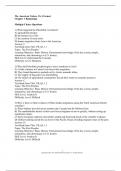Exam (elaborations)
Test Bank for The American Nation: A History of the United States Volume 1 15th Edition by Mark C. Carnes, (All Chapters 1-15)
- Course
- Institution
Test Bank for The American Nation: A History of the United States Volume 1 15th Edition by Mark C. Carnes, (All Chapters 1-15)
[Show more]



